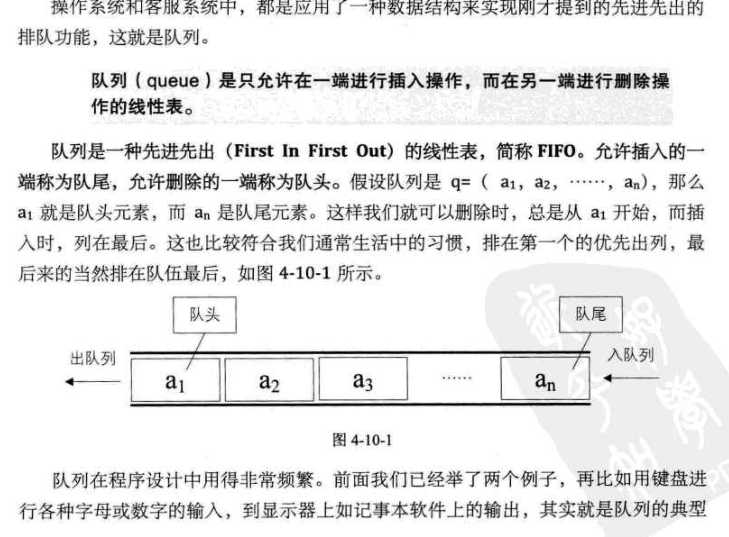标签:实现 typedef 概念 com 不能 current class node pac
队列是一种特殊的线性表
队列仅在线性表的两端进行操作
队头(Front):取出数据元素的一端
队尾(Rear):插入数据元素的一端
队列不允许在中间部位进行操作!

常用操作
seqlist.h
#ifndef __MY_SEQLIST_H__ #define __MY_SEQLIST_H__ #define DLL_API __declspec(dllexport) //_declspec(dllexport):导出标志 typedef void SeqList; typedef void SeqListNode; // 创建线性表 DLL_API SeqList* SeqList_Create(int capacity); // 销毁线性表 DLL_API void SeqList_Destroy(SeqList *list); // 清空线性表 DLL_API void SeqList_Clear(SeqList *list); // 获得线性表的长度 DLL_API int SeqList_Length(SeqList *list); // 获得线性表的容量 DLL_API int SeqList_Capacity(SeqList *list); // 向线性表中插入一个元素 DLL_API int SeqList_Insert(SeqList *list, SeqListNode *node, int pos); // 获取线性表中某一个位置的元素 DLL_API SeqListNode* SeqList_Get(SeqList *list, int pos); // 删除线性表中某一个位置的元素 DLL_API SeqListNode* SeqList_Delete(SeqList *list, int pos); #endif
seqlist.c
#include <stdio.h> #include <stdlib.h> #include <string.h> #include "seqlist.h" typedef struct _tag_SeqList { int capacity; int length; unsigned int *node; // unsigned int array[capacity] }TSeqList; // 创建线性表 SeqList* SeqList_Create(int capacity) { TSeqList *ret = NULL; if (capacity < 0) { return NULL; } ret = malloc(sizeof(TSeqList) + sizeof(unsigned int)*capacity); if (ret == NULL) { return NULL; } memset(ret, 0, sizeof(TSeqList)+sizeof(unsigned int)*capacity); ret->node = (unsigned int *)(ret + 1); // ret 向后跳转sizeof(TSeqList) ret->capacity = capacity; ret->length = 0; return ret; } // 销毁线性表 void SeqList_Destroy(SeqList *list) { if (list != NULL) { free(list); } } // 清空线性表 void SeqList_Clear(SeqList *list) { TSeqList *tList = NULL; if (list == NULL) { return; } tList = (SeqList*)list; tList->length = 0; } // 获得线性表的长度 int SeqList_Length(SeqList *list) { TSeqList *tList = NULL; tList = (TSeqList*)list; if (tList == NULL) { return -1; } return tList->length; } // 获得线性表的容量 int SeqList_Capacity(SeqList *list) { TSeqList *tList = NULL; tList = (TSeqList*)list; if (tList == NULL) { return -1; } return tList->capacity; } // 向线性表中插入一个元素 DLL_API int SeqList_Insert(SeqList *list, SeqListNode *node, int pos) { int i = 0; TSeqList *tList = NULL; tList = (TSeqList*)list; // 保证传入的线性表和元素节点不能为NULL if (list == NULL || node == NULL) { return -1; } // 判断该线性表是否已满 if (tList->length >= tList->capacity) { return -2; } // 判断插入索引是否合法 if (pos < 0 || pos >= tList->capacity) { return -3; } // 若索引值大于线性表当前长度,则将元素插入到线性表的末尾 if (pos >= tList->length) { pos = tList->length; } // 插入算法 // 将pos位置后的元素移次向后移 for (i = tList->length; i > pos; i--) { // 更新后移元素的值 tList->node[i] = tList->node[i - 1]; } // 元素后移完毕后,将元素放到指定的位置 tList->node[pos] = (unsigned int)node; tList->length ++; return 0; } // 获取线性表中某一个位置的元素 SeqListNode* SeqList_Get(SeqList *list, int pos) { SeqListNode *ret = NULL; TSeqList *tList = NULL; tList = (TSeqList*)list; // 过滤非法参数 if (list == NULL || pos < 0 || pos >= tList->length) { return NULL; } ret = (SeqListNode*)tList->node[pos]; return ret; } // 删除线性表中某一个位置的元素 SeqListNode* SeqList_Delete(SeqList *list, int pos) { int i = 0; TSeqList *tList = NULL; SeqListNode *ret = NULL; tList = (TSeqList*)list; if (list == NULL || pos < 0 || pos >= tList->length) { return NULL; } ret = (SeqListNode*)tList->node[pos]; // 删除算法 for (i=pos+1; i<tList->length; i++) { tList->node[i - 1] = tList->node[i]; } tList->length--; return ret; }
seqqueue.h
#ifndef __MY_SEQ_QUEUE_H__ #define __MY_SEQ_QUEUE_H__ typedef void SeqQueue; // 创建队列 SeqQueue* SeqQueue_Create(int capacity); // 销毁队列 void SeqQueue_Destroy(SeqQueue* queue); // 清空队列 void SeqQueue_Clear(SeqQueue* queue); // 向队尾添加元素 int SeqQueue_Append(SeqQueue* queue, void* item); // 移除队列头部元素 void* SeqQueue_Retrieve(SeqQueue* queue); // 获取队列头部元素 void* SeqQueue_Header(SeqQueue* header); // 获取队列长度 int SeqQueue_Length(SeqQueue* length); // 获取队列容量 int SeqQueue_Capacity(SeqQueue* queue); #endif
seqqueue.c
#include "seqqueue.h" #include "seqlist.h" // 创建队列 SeqQueue* SeqQueue_Create(int capacity) { return SeqList_Create(capacity); } // 销毁队列 void SeqQueue_Destroy(SeqQueue* queue) { SeqList_Destroy(queue); } // 清空队列 void SeqQueue_Clear(SeqQueue* queue) { SeqList_Clear(queue); } // 向队尾添加元素,相当于向线性表的尾部插入元素 int SeqQueue_Append(SeqQueue* queue, void* item) { return SeqList_Insert(queue, item, SeqList_Length(queue)); } // 移除队列头部元素 void* SeqQueue_Retrieve(SeqQueue* queue) { return SeqList_Delete(queue, 0); } // 获取队列头部元素 void* SeqQueue_Header(SeqQueue* queue) { return SeqList_Get(queue, 0); } // 获取队列长度 int SeqQueue_Length(SeqQueue* queue) { return SeqList_Length(queue); } // 获取队列容量 int SeqQueue_Capacity(SeqQueue* queue) { return SeqList_Capacity(queue); }
运行结果:
current queue capacity is: 10
current queue length is: 6
current student age is: 12
current new length is: 0
请按任意键继续. . .
标签:实现 typedef 概念 com 不能 current class node pac
原文地址:http://www.cnblogs.com/yongdaimi/p/7266983.html